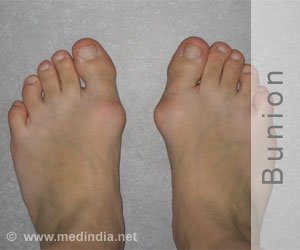New Procedure for Treating Bunions

“When someone has a flatfoot deformity, which is essentially a fallen arch, the idea is that fixing the bunion through this minimally invasive technique could make the flatfoot worse because we cut the bones closer to the toe. What we found is that it was quite the oppositethat fixing the bunion in a minimally invasive way caused no changes in the overall flatfoot dimensions.”
“Bunion” is an umbrella term describing a variety of painful deformities at the base of the big toe. In the most common type of bunion, called hallux valgus, the big toe turns inward from its normal position and angles toward the second toe. Hallux valgus often presents with secondary structural deformities such as flatfoot, which can be symptomatic or asymptomatic (causing no symptoms).
All techniques for treating bunions involve cutting the bones and repositioning them with metal screws. The minimally invasive chevron and akin bunionectomy (MISB) fixes the bunion by cutting the bones through tiny incisions in the skin. “The advantages of doing the surgery through small incisions include minimal to no pain after the surgery; immediate weight bearing, so you can walk normally on the foot; and faster return to day-to-day activities and sports,” said Dr. Johnson.
Minimally Invasive Bunion Surgery
The researchers conducted a retrospective study using a patient registry at HSS. In the registry, they identified patients who were over 18 years of age and were diagnosed with a bunion deformity between 2016 and 2021. Of this cohort, patients were included in the study if they underwent a MISB procedure to correct a hallux valgus deformity; reported their outcomes for at least one year and up to two years, as recorded by a patient-reported outcomes tool known as PROMIS; and had x-rays before and three months after surgery, at minimum. Using preoperative x-rays, the team identified individuals who had evidence of flatfoot; using a chart review, they also identified those with an asymptomatic flatfoot. These reviews yielded a study group of 35 patients with asymptomatic flatfoot and 47 patients without flatfoot.
Advertisement
“We collected PROMIS surveys on all our patients. These are a series of questionnaires that have been validated for use in foot and ankle research and ask the patient about their function, pain, and mental health,” said Rami Mizher, lead author of the study and a research assistant in the Department of Foot and Ankle Surgery at HSS. The researchers found that MISB resulted in similar improvements in the two groups in physical function, pain interference (how often the pain interferes with daily life), pain intensity, and global physical health (overall patient health), as measured by the PROMIS survey. There were no significant preoperative to postoperative changes in PROMIS global mental health and depression measures in either group.
A chart review showed there was no difference in complications in the two study groups.
The researchers also examined pre- and post-operative x-rays to clinically assess how well the surgery corrected the bunion deformity and if it changed any of the flatfoot-related measurements. In both groups, there was a similar correction of the bunion deformity. In terms of the flatfoot outcomes, the researchers looked at three different parameters: calcaneal pitch, or the height of the foot arch; Meary’s angle, which measures how much a foot sags; and talonavicular coverage angle, which measures how much the foot turns outward. The first two measures didn’t have any significant changes, while the talonavicular coverage angle improved in the flatfoot group.
Source: Newswise
Source link
#Procedure #Treating #Bunions



